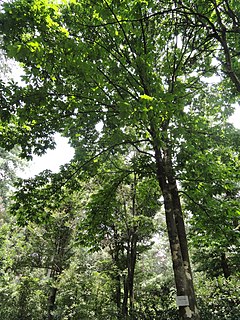
Soil is a mixture of organic matter, minerals, gases, liquids, and organisms that together support life. Earth's body of soil, called the pedosphere, has four important functions:

QI is a British comedy panel game television quiz show created and co-produced by John Lloyd, and features permanent panellist Alan Davies. Stephen Fry was host of the show from its initial pilot, before departing after the final episode of the M series in 2016, exactly halfway through the alphabet, with frequent QI panellist Sandi Toksvig replacing him at the beginning of the N series in 2016.

Prunus spinosa, called blackthorn or sloe, is a species of flowering plant in the rose family Rosaceae. It is native to Europe, western Asia, and locally in northwest Africa. It is also locally naturalized in New Zealand, Tasmania and eastern North America.

Salix × fragilis, with the common names crack willow and brittle willow, is a hybrid species of willow native to Europe and Western Asia. It is native to riparian habitats, usually found growing beside rivers and streams, and in marshes and water meadow channels. It is a hybrid between Salix euxina and Salix alba, and is very variable, with forms linking both parents.

Quercus frainetto, commonly known as the Hungarian oak or Italian oak, is a species of oak, native to southeastern Europe and Turkey; it is classified in Quercus sect. Mesobalanus.

Picea omorika, common name Pančić spruce or Serbian spruce, is a species of coniferous tree endemic to the Drina River valley in western Serbia, and eastern Bosnia and Herzegovina, with a total range of only about 60 ha, at 800–1,600 m (2,625–5,249 ft) altitude. It was originally discovered near the Serbian village of Zaovine, on Mount Tara, in 1875, and named by the Serbian botanist Josif Pančić; the specific epithet omorika is simply the Serbian word for the tree..

Aesculus hippocastanum, the horse chestnut, is a species of flowering plant in the soapberry and lychee family Sapindaceae. It is a large deciduous, synoecious (hermaphroditic-flowered) tree. It is also called horse-chestnut, European horsechestnut, buckeye, and conker tree. It is sometimes called Spanish chestnut. This name is typically used for Castanea sativa.

Acer tataricum, the Tatar maple or Tatarian maple, is a species of maple widespread across central and southeastern Europe and temperate Asia, from Austria and Turkey east as far as Japan and the Russian Far East. The species is named after the Tatar peoples of southern Russia; the tree's name is similarly commonly also misspelled "Tartar" or "Tartarian" in English.

The Dutch hybrid cultivar Ulmus 'Dodoens' was derived from a selfed seedling of a crossing of the Exeter Elm Ulmus 'Exoniensis' with the Himalayan Elm Ulmus wallichiana at the Dorschkamp Research Institute for Forestry & Landscape Planning, Wageningen. The tree was one of several cultivars prepared for release in 1970, but delayed by the outbreak of the second, far more aggressive strain of Dutch elm disease.

Ulmus 'Plantyn' was one of three Dutch hybrid elms released by the Dorschkamp Research Institute for Forestry & Landscape Planning, Wageningen, in 1973. Derived from a crossing of the Dutch hybrids '202' and '302', it was to prove of great significance in later developments. A selfed seedling was to become the first Dutch clone to prove effectively immune to disease, released in 1989 as 'Columella'. 'Plantyn' was also destined to be the female parent of Lutèce released in 2002. In Italy, 'Plantyn' was used again as female parent in hybridizations with the Siberian Elm Ulmus pumila by the Istituto per la Protezione delle Piante (IPP), to create three new cultivars better adapted to the Mediterranean climate.

Myrica faya is a species of Myrica, native to Macaronesia, and possibly also western coastal mainland Portugal.
Aralia hypoglauca is a species of flowering plant in the family Araliaceae. It has been treated as the only species Hunaniopanax hypoglaucus of the genus Hunanioglaucus.

Prunus lusitanica, the Portuguese laurel cherry or Portugal laurel, is a species of flowering plant in the rose family Rosaceae, native to southwestern France, Spain, Portugal, Morocco, and Macaronesia.

Aesculus wangii is a species of tree in the family Sapindaceae, found in southern China (Yunnan) and northern Vietnam. It is threatened by habitat loss. Sometimes considered conspecific with Aesculus assamica.

Sorbus commixta, the Japanese rowan, is a species of flowering plant in the family Rosaceae, native to Japan, Sakhalin, and the Korean island of Ulleungdo.

Alniaria alnifolia, also called alder-leafed whitebeam, Korean whitebeam, or Korean mountain ash, Chinese: 水榆花楸; pinyin: shui yu hua qiu; lit. 'water elm rowan', is a species of whitebeam native to eastern Asia in eastern and northern China, Taiwan, Korea and Japan.

TMSR-LF1 is a 2 MWt prototype molten salt reactor (MSR) currently under construction in an industrial park in Minqin County, in the province of Gansu in northwest China. Construction is expected to finish in August 2021, with a test run as early as September.

Alniaria folgneri, Folgner's whitebeam, is a species of flowering plant in the family Rosaceae, native to central China. A small tree, the abaxial side of its soft leaves are covered in a silvery-white tomentose layer. Its autumn foliage often turns golden pink, set off by the white undersides, but the intensity of the color varies from year to year. Its cultivar 'Emiel' has gained the Royal Horticultural Society's Award of Garden Merit.

















